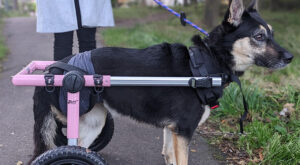Pets can become part of the family overnight. They offer a lifetime of companionship and love. Whether you’ve adopted a disabled pet or yours has formed a disability over the years, it doesn’t make them any less capable of providing you with unconditional love and joy. However, there are some challenges pets with disabilities have to face that their more able-bodied counterparts don’t usually struggle with. One of those challenges is navigating their way around the house.
Your pet should be able to feel comfortable in your home, and that includes having the ability to move around with ease.
Thankfully, there are a few simple things you can do to make life easier for your disabled pet at home, starting with reconsidering the way things are arranged. Let’s cover a few tips that will make a big difference in your pet’s comfort level.
Set Up a Separate Room
Every pet deserves to feel safe. Dogs, especially, are considered den animals. So, it’s not uncommon for them to feel better in a more enclosed area. If your pet is disabled, having a designated safe space for them can be even more beneficial.
Consider setting up a pet room for your furry friend. You can customize it to fit their needs while giving them a safe and quiet space to relax. While every pet’s room will be a little different, there are a few basics you should invest in, including
- Pet-friendly furniture
- Sturdy and safe furniture and decor
- Comfortable pillows and blankets
- Upholstery and rugs that work well for pets
- Minimize clutter for ease of navigating
Depending on your companion’s disability, you should also consider things like beds that are low to the ground so they can safely get in and out without straining themselves or risking injury.
Make sure to make your pet’s room fun and stimulating, too! Consider some pet-themed decor. Toss in a few of their favorite toys. Have a treat dispenser that makes it easy for them to get something tasty by pushing a button or working through a puzzle. The room should be a sort of “safe haven” and a playroom for your friend, not just a place for them to hide away from the rest of the household.
Make Simple Modifications
You don’t need to make drastic changes across your home to make things more accessible for your pet. A few simple modifications can go a long way, especially if they have mobility issues. The best thing you can do is assess their needs. You know what they’re capable of and where they struggle. Every modification you make should center around those needs to make navigating through the house as easy as possible for them.
Once you have a better understanding of their needs, consider what you can do to make things safer for them.
Minimize Clutter In Your Home Arranging
Try to minimize clutter so your pet doesn’t trip over things. Install small ramps leading up to your bed or other pieces of furniture they’re allowed on. Place non-slip treads on your stairs to keep them from falling as they try to get around. Add rugs or carpet tiles around your home, not only for comfort but to reduce the chances of slipping, as well.
When you’re considering your pet’s needs and home arranging go back to the basics. Modifications like raised food and water bowls can be easier on a pet with arthritis so they don’t have to bend down as far.
If your dog or cat has mobility issues or can’t move around quickly, it’s also important to make sure they can relieve themselves comfortably. The last thing you want is to deal with frequent accidents around the home, and if your pet is used to being housetrained, they don’t want that either!
Easy Navigating For Your Cat or Dog
If you have a cat, you can help to prevent that with multiple litter boxes. Put one in a few different rooms, so no matter where your feline friend is, they won’t have to go far to use the bathroom.
For dogs, consider installing a pet door that allows them to easily go in and out without having to wait on someone. Measure the height and weight of your dog before installing a door, so they’ll have ample room to get in and out easily – especially with mobility issues. You might also consider a bed specifically for incontinent pets, for those times when they’re sleeping and aren’t able to make it outside in time. Alongside these beds, a pet door is another great way to reduce the risk of accidents, so consider installing one on all entry doors to your home.
Foster a Thriving Lifestyle
Arranging your home to make life easier for your disabled pet is only half the battle. One of the best things you can do is to encourage a lifestyle that helps them thrive. That includes things like
- Regular exercise
- A healthy diet
- Mental stimulation
- Medical care
Depending on your pet’s disability, they may have limits. However, that doesn’t mean they shouldn’t be safely challenged and encouraged. A disabled pet doesn’t have to have a low quality of life.
To help your pet remain comfortable, consider certain types of therapies. Physical therapy can help with mobility issues and alleviate pain. Like humans, pets can also benefit from water therapy since it’s easy on the joints and provides a great cardiovascular workout. Supplements and aids like wheelchairs or harnesses can also make life easier for your dog or cat both in and out of the home.
In addition to arranging your home a certain way, adapting your daily routine can make a difference in your pet’s ability to thrive. Having a specific routine your pet can follow will make it easier on them when it comes to mealtime, “potty time,” and knowing when and how to get to their safe space. Routines also provide comfort and security – something every animal benefits from.
As a pet owner, you would do almost anything for your furry companion. While taking care of a disabled pet can come with a few more obstacles, it’s worth it to go the extra mile for them. By rearranging a few things at home and encouraging a healthy quality of life, your pet’s disability won’t keep them down, and you’ll be able to enjoy many more loving moments together.
Guest Author:
Charlie Fletcher
Charlie Fletcher is a freelance writer and pet parent from the lovely “city of trees”- Boise, Idaho. Her love of writing pairs with her passion for animal rights and search for the truth. You can find more of her writing on her Contently.
Related Articles:








